
Eantis mithridates, also known as the sickle-winged skipper or Jung's dusky wing, is a species of butterfly in the family Hesperiidae. It is found from Argentina, north through tropical America and the West Indies to southern Texas. A regular stray north to central Texas, rarely to Arkansas and Kansas.

Anthanassa frisia, the Cuban crescentspot, Cuban checkerspot or Cuban crescent, is a butterfly of the family Nymphalidae. Subspecies tulcis is known by the common names pale-banded crescent or Tulcis crescent; it is treated as a species by some authors.

Zizula cyna, the cyna blue, is a butterfly species in the family Lycaenidae.

Calpodes ethlius, the Brazilian skipper, larger canna leafroller or canna skipper, is a butterfly of the family Hesperiidae. It is found in the United States from southern Florida and southern Texas, south through the West Indies, Mexico, and Central America to Argentina. Strays and temporary colonies can be found north to southern Nevada, northern Texas, Illinois and Massachusetts.

Wallengrenia egeremet, the northern broken dash , is a butterfly of the family Hesperiidae. It is found in North America from southern Maine and southern Ontario, west across the Great Lakes states to southeastern North Dakota, south to central Florida, the Gulf Coast and south-eastern Texas.
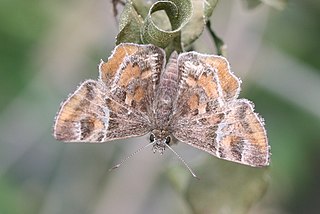
Systasea pulverulenta, the Texas powdered skipper, is a butterfly of the family Hesperiidae. It is found in North America from southern and western Texas, south through Mexico to Guatemala in Central America.
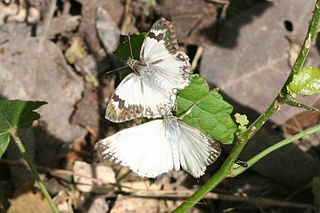
Heliopetes macaira, the Turk's-cap white-skipper , is a butterfly of the family Hesperiidae. It is found from southern Texas in North America, south through Central America to Paraguay.

Celotes nessus, the common streaky-skipper, is a butterfly of the family Hesperiidae. It is found in North America from southern Arizona, southern New Mexico, and western Texas south to northern Mexico. Rare strays can be found up to southern Oklahoma and northern Louisiana.

Copaeodes minima, the southern skipperling, is a butterfly of the family Hesperiidae. It is found in the United States from Arkansas east to North Carolina, south through Florida, the Gulf States, Texas, and Mexico to Panama.

Papilio astyalus, the broad-banded swallowtail or Astyalus swallowtail, is a butterfly of the family Papilionidae. It is found from Mexico south to Argentina. It is occasionally reported from southern Texas and rare strays can be found up to southern Arizona and northern Texas.

Eurema daira, the fairy yellow, barred yellow or barred sulphur, is a butterfly of the family Pieridae. The species was first described by Jean-Baptiste Godart in 1819. It is found from Argentina north to the southern United States. Strays can be found up to southern Arizona, South Dakota, southern Texas and even Washington, D.C.
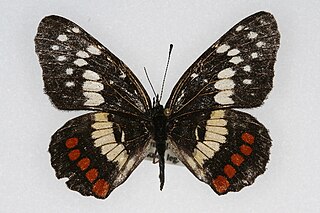
Chlosyne marina, the red-spotted patch or marina checkerspot, is a butterfly of the family Nymphalidae. It is found in Mexico. Rare strays can be found as far north as southern Arizona and southern Texas.
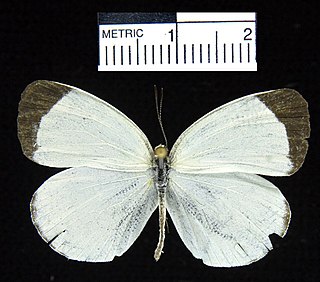
Eurema albula, the ghost yellow, is a butterfly in the family Pieridae. It is found from southern Texas south through the West Indies and mainland tropical Central and South America to Brazil. The habitat consists of tropical forests and second growth.

Eurema boisduvaliana, commonly known as Boisduval's yellow, is a butterfly in the family Pieridae. It is found from Costa Rica north to Mexico. Rare strays may be found in southern Florida, but it is a regular migrant to south-eastern Arizona, south-western New Mexico, and southern Texas. The habitat consists of subtropical forests and forest edges, scrubs, roadsides and pastures.

Pyrisitia nise, the mimosa yellow, is a butterfly in the family Pieridae. It is found from Argentina north to the Texas Gulf Coast and throughout central and southern Florida, northward to the Tennessee Valley. It is an occasional stray to central Texas and south-eastern Arizona and rarely to southern California, southern Colorado and Kansas. The habitat consists of brushy woodland edges.
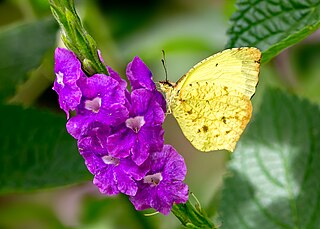
Eurema salome, the Salome yellow, is a butterfly in the family Pieridae. It is found from Peru northward through tropical America. It is an extremely rare migrant to the lower Rio Grande Valley in Texas. The habitat consists of forest openings and edges and roadcuts.

Mestra is a genus of nymphalid butterfly. It contains the single species Mestra dorcas, the Jamaican mestra, which is found from southern North America to South America and possibly Mestra cana, the St Lucia mestra, found in the Lesser Antilles.

Rekoa marius, the Marius hairstreak, is a butterfly in the family Lycaenidae. It is found from Paraguay north to Sonora in Mexico. Strays may be found as far north as southern Texas. The species used to be considered rare in the southern Texas. It is the species of Rekoa found in Arizona. The habitat consists of disturbed tropical areas.

Anthanassa texana, the Texan crescentspot, is a species of butterfly in the family Nymphalidae. It is found from Guatemala north through Mexico to southern California, east across the southern United States to northern Florida, Georgia and South Carolina. Strays may be found up to Arkansas, Missouri, Illinois, South Dakota, and central Nevada. The habitat consists of deserts, dry gulches, open areas, streamsides, road edges, and city parks.
Chlorostrymon telea, the telea hairstreak, is a butterfly of the family Lycaenidae. It was described by William Chapman Hewitsonin 1868. It is found from southern Texas and Mexico to Colombia, Uruguay, Paraguay, eastern Bolivia, Argentina and Chile. The habitat consists of stream valleys of semideciduous dry forests.



















